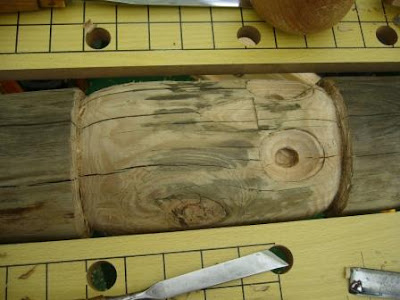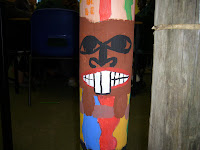I spent a couple of hours at the school this afternoon. There are about 25 children in the class, aged between 9 and 11. I was shown the Totem Pole they had painted and they told me the story that it depicted. We talked a little about the different types of Totems and where they came from. It was obvious that they had done considerable background work on the subject.
I then showed them some of the tools of the carver's trade, the gouges, chisels, mallets, etc. and described how they are used.
I got some of them to have a go at cutting a few pieces of scrap wood, but fairly soon we decided that it would be nice if we could start on the actual pole itself. This is a garden post 1300mm long and 115mm in diameter. It is a fairly rough weathered pine post with several knots and quite a lot of surface splitting.
I decided that we could incise a separator line between each of the four animals, so having got some of the children to compare the new post with their painted pole we pencil marked where the cuts should be.
I mounted the post on a sturdy table, using a 'Jobber' and a cramp. Although this was a bit low for me, it was a suitable height for the children.
Each child successfully carved a small section of the encircling incisions needed, using a large flat (No 3) Gouge and a mallet. Meanwhile the rest of the children did some modeling of the animals in plasticine.
The first incisions:
At the end of the session I agreed with the teacher that it would be nice if we could carry on with the project. I agreed to come into the school again the following week, and then to continue working on the pole during the summer break, with the intention to have it finished in time for the School's centenary in October.

















